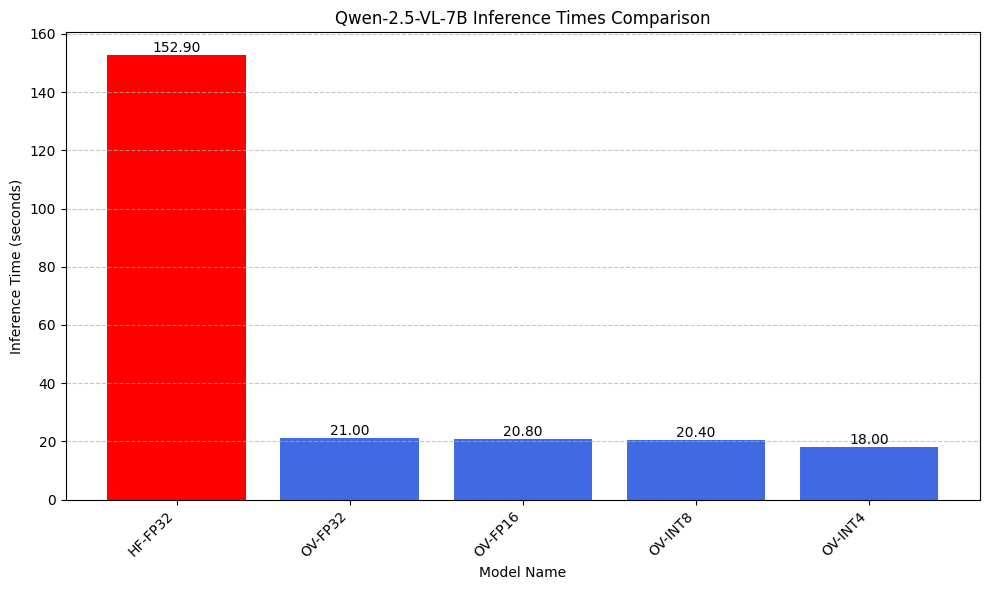Author
Published
7 Oct 2025Form Number
LP2305PDF size
8 pages, 247 KBAbstract
Multimodal Large Language Models (MMLLMs) are rapidly transforming how enterprises interact with data by combining visual and textual understanding into a single unified AI system. From document processing and customer service chatbots to manufacturing quality inspection, the ability to reason over images and text is opening new frontiers in productivity and automation. However, the high computational demand of MMLLMs has traditionally required GPU-based infrastructure, which can be costly.
This paper demonstrates how MMLLM inference can be accelerated on Lenovo ThinkSystem SR650 V4 servers powered by Intel Xeon 6 processors, using Intel’s OpenVINO toolkit. By optimizing models such as Qwen2.5-VL-7B-Instruct, we show how CPU-based deployments can achieve significant performance improvements compared to standard Hugging Face implementations, enabling enterprises host multimodal AI cost effectively without relying on specialized GPU clusters.
Introduction
Large language models (LLMs) have rapidly advanced from processing text alone to understanding and generating content across multiple modalities, including images, video, and audio. These multimodal LLMs (MM-LLMs) enable a wide range of enterprise applications from document intelligence that can parse images of receipts and contracts, to customer support systems that can reason over both text and product images, to manufacturing workflows that combine defect detection with natural language reporting.
While the capabilities of MM-LLMs are transformative, their deployment poses practical challenges. Multimodal architectures typically combine a vision encoder with a large-scale transformer, resulting in substantial compute and memory requirements. Traditionally, such models have been run on GPUs, but GPU availability, cost, and energy consumption often limit adoption.
The latest Intel Xeon 6 processors, paired with Lenovo ThinkSystem servers, deliver new architectural enhancements such as Intel Advanced Matrix Extensions (AMX), high memory bandwidth, and increased core density, making them well-suited for AI inference workloads that previously demanded accelerators. When combined with OpenVINO, Intel’s open-source toolkit for deep learning optimization, Xeon 6 processors provide a cost-effective and efficient path to deploy MM-LLMs.
In this paper, we demonstrate how to accelerate a state-of-the-art multimodal LLM, Qwen2.5-VL-7B-Instruct on a Lenovo ThinkSystem SR650 V4 server powered by Intel Xeon 6 processors. We compare a standard Hugging Face implementation against an OpenVINO-optimized workflow, highlighting performance gains in inference speed and efficiency. The results show that enterprises can deploy powerful multimodal AI solutions without relying on costly or scarce GPU resources.
ThinkSystem SR650 V4
The Lenovo ThinkSystem SR650 V4, powered by the latest Intel Xeon 6 processors, provides a flexible and scalable foundation for next-generation AI workloads. Designed for performance, efficiency, and reliability, the SR650 V4 is ideal for organizations looking to deploy demanding multimodal applications across data center and enterprise environments.

Figure 1. Lenovo ThinkSystem SR650 V4
At the heart of the SR650 V4, the Intel Xeon 6 delivers a leap in AI acceleration, thanks to features such as Advanced Matrix Extensions (AMX) and AVX-512, which unlock significant gains in transformer-based models. With expanded memory bandwidth, increased core density, and built-in support for AI instructions, Xeon 6 is engineered to meet the growing demands of multimodal workloads that integrate both vision and language reasoning.
When combined, Lenovo’s proven server engineering and Intel’s AI-optimized silicon create a platform that delivers:
- Scalable performance for large-scale LLM and vision workloads without the need for GPUs.
- Lower total cost of ownership (TCO) by leveraging existing CPU-based infrastructure.
- Enterprise-grade reliability for production deployments in mission-critical environments.
- Optimized AI performance with OpenVINO, ensuring seamless integration between hardware and software.
Together, the Lenovo SR650 V4 and Intel Xeon 6 offer enterprises the ability to deploy multimodal AI at scale, with performance, efficiency, and flexibility that align with real-world business needs.
OpenVINO Acceleration
In the following steps, we demonstrate how to run the same Qwen2.5-VL-7B-Instruct model optimized using OpenVINO.
- Create a python virtual environment and install the needed packages.
It is highly recommended to use a uv python virtual environment to ensure compatibility between packages, but a standard python virtual environment will work as well. Run the following on the command line.
uv venv ov_env source ov_env/bin/activate uv pip install "torch>=2.1" "torchvision" "qwen-vl-utils" "Pillow" "gradio>=4.36" --extra-index-url https://download.pytorch.org/whl/cpu uv pip install -q -U "openvino>=2025.0.0" "openvino-tokenizers>=2025.0.0" "nncf>=2.15.0" uv pip install -q "git+https://github.com/huggingface/optimum-intel.git" --extra-index-url https://download.pytorch.org/whl/cpu uv pip install -q "transformers>=4.49" - Download Multimodal LLM.
Here we may download the Qwen2.5-VL-7B-Instruct model, convert it to OpenVINO’s optimized Intermediate Representation (IR) and quantize it into an int4 representation to quicken inference speeds and reduce model footprint. Readers are encouraged to experiment with other weight formats such as bf16, and int8.
optimum-cli export openvino --model Qwen/Qwen2.5-VL-7B-Instruct Qwen2.5-VL-7B-Instruct-OV-INT4 --weight-format int4 - Import packages.
from optimum.intel.openvino import OVModelForVisualCausalLM from PIL import Image from transformers import AutoProcessor, AutoTokenizer from qwen_vl_utils import process_vision_info from transformers import TextStreamer - Download and define sample image.
While any image will work, we suggest downloading and saving the image found at this url to a local directory:
https://github.com/openvinotoolkit/openvino_notebooks/assets/29454499/d5fbbd1a-d484-415c-88cb-9986625b7b11 - Define model and processor.
The model should match the model we exported earlier; the purpose of the processor is to encode data from both the text and image modalities into the model.
model = OVModelForVisualCausalLM.from_pretrained("Qwen2.5-VL-7B-Instruct-OV-INT4") processor = AutoProcessor.from_pretrained("Qwen2.5-VL-7B-Instruct-OV-INT4") - Define prompt and encode.
messages = [ { "role": "user", "content": [ { "type": "image", "image": f"file://{example_image_path}", }, {"type": "text", "text": question}, ], } ] text = processor.apply_chat_template(messages, tokenize=False, add_generation_prompt=True) image_inputs, video_inputs = process_vision_info(messages) inputs = processor( text=[text], images=image_inputs, videos=video_inputs, padding=True, return_tensors="pt", ) - Generate output.
Finally a call to model.generate is all that is needed to create an output.
generated_ids = model.generate(**inputs, max_new_tokens=128)
Results
We conducted a simple speed comparison of Qwen-2.5-VL-7B running on both Huggingface and OpenVINO using various weight compressions. We give each the same image and prompt “Please describe the image.” while limiting the models to 128 generation tokens. We test five variations of Qwen-2.5-VL-7B: fp32 with huggingface and fp32, fp16, int8, and int4 with OpenVINO.
Our results are shown in the following figure. Shown is the average of 30 runs with a single input image, the prompt "Please describe the image.", and a maximum of 128 output tokens.

Figure 2. Comparison of Huggingface model versus OpenVINO at various quantizations
Simply converting the model to OpenVINO while keeping the same fp32 precision results in a 7.28x speed-up. Further weight compressing the model from fp32 to int4 results in a 1.17x relative speed-up. Combined this results in a staggering 8.49x speed-up over the standard Huggingface implementation.
Conclusion
This paper has demonstrated a powerful and cost-effective alternative for deploying multimodal large language models (MM-LLMs) without relying on traditional, expensive GPU-centric infrastructure. By leveraging the AI-optimized capabilities of Intel Xeon 6 processors and the deep-learning optimizations of the OpenVINO toolkit, we achieved a 8.49x performance speed-up for the Qwen2.5-VL-7B-Instruct model compared to its standard Hugging Face implementation.
Our results validate the synergy between Intel's purpose-built hardware and its simple yet powerful software ecosystem. The new Intel Advanced Matrix Extensions (AMX) on Xeon 6 processors, when fully utilized by OpenVINO, unlocks a new level of AI performance on standard CPUs. This is particularly significant for enterprises that have already invested in CPU-based infrastructure for their data centers. The combination of Lenovo ThinkSystem servers and Intel Xeon 6 processors presents a compelling path to harness the transformative potential of MM-LLMs for applications like document intelligence, quality control, and customer support, while significantly reducing total cost of ownership (TCO) and energy consumption.
In an era where enterprises are seeking to democratize AI and deploy it at scale, the path forward is not always through specialized, costly accelerators. This work proves that powerful, efficient, and scalable multimodal AI inference is not only possible but practical on a CPU-based platform. The integration of OpenVINO and Intel's next-generation silicon offers a robust and economical solution, empowering organizations to deploy advanced AI models with unparalleled efficiency.
Hardware Details
The following table lists the key components of the server we used in our performance tests.
Author
Eric Page is an AI Engineer at Lenovo. He has 6 years of practical experience developing Machine Learning solutions for various applications ranging from weather-forecasting to pose-estimation. He enjoys solving practical problems using data and AI/ML.
Trademarks
Lenovo and the Lenovo logo are trademarks or registered trademarks of Lenovo in the United States, other countries, or both. A current list of Lenovo trademarks is available on the Web at https://www.lenovo.com/us/en/legal/copytrade/.
The following terms are trademarks of Lenovo in the United States, other countries, or both:
Lenovo®
ThinkSystem®
The following terms are trademarks of other companies:
Intel®, the Intel logo, OpenVINO®, and Xeon® are trademarks of Intel Corporation or its subsidiaries.
Linux® is the trademark of Linus Torvalds in the U.S. and other countries.
Other company, product, or service names may be trademarks or service marks of others.
Configure and Buy
Full Change History
Course Detail
Employees Only Content
The content in this document with a is only visible to employees who are logged in. Logon using your Lenovo ITcode and password via Lenovo single-signon (SSO).
The author of the document has determined that this content is classified as Lenovo Internal and should not be normally be made available to people who are not employees or contractors. This includes partners, customers, and competitors. The reasons may vary and you should reach out to the authors of the document for clarification, if needed. Be cautious about sharing this content with others as it may contain sensitive information.
Any visitor to the Lenovo Press web site who is not logged on will not be able to see this employee-only content. This content is excluded from search engine indexes and will not appear in any search results.
For all users, including logged-in employees, this employee-only content does not appear in the PDF version of this document.
This functionality is cookie based. The web site will normally remember your login state between browser sessions, however, if you clear cookies at the end of a session or work in an Incognito/Private browser window, then you will need to log in each time.
If you have any questions about this feature of the Lenovo Press web, please email David Watts at dwatts@lenovo.com.
